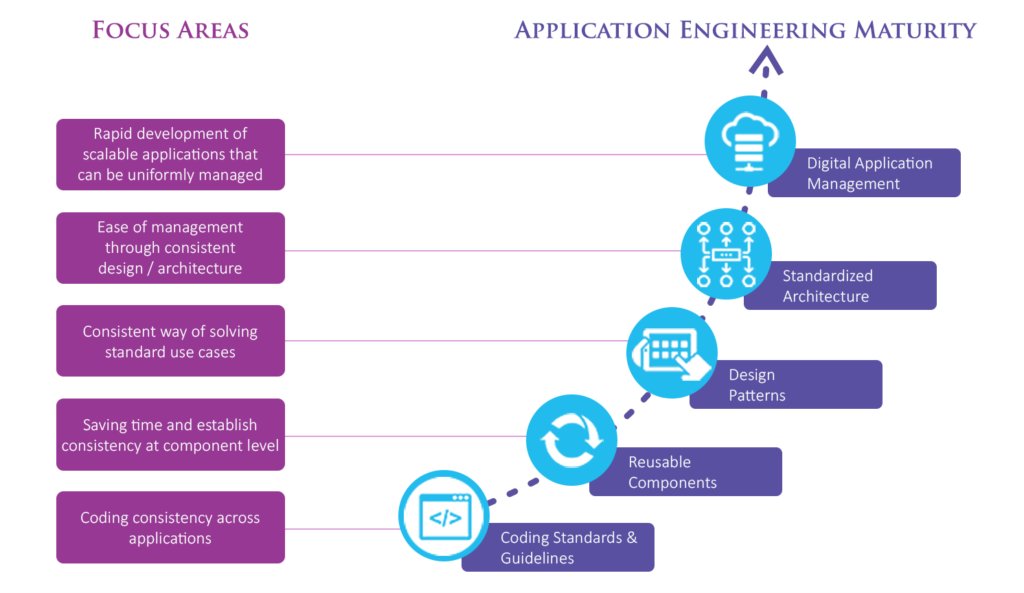Application engineering has been going through steady changes since its inception. However, the last couple of years have turned the whole software engineering aspect on its head. One of the key reasons behind this impact is the digital transformation that several of the enterprises are going through currently.
The above picture shows the transition of Application Engineering maturity models and their key focus areas. The earlier maturity models were more focused on establishing consistency either at an application level or a component level. Only during the mid-periods the focus shifted towards design and architecture. Design patterns, technology stack and architecture were the focus, which helped in bringing design level consistency across the applications.
Digital Application Management – Maturity Model
However, the digital transformation wave has created a significant shift in the application engineering approach, where the focus is not just on rapid development of applications but also the way in which the applications are managed at an enterprise level. In additional to the coding and design level consistency, the current maturity model emphasizes on the consistency in administration of these applications.
10 Key Components for achieving Digital Application Management Maturity Model
- Code Templates – Pre-defined templates of code for standard use cases/business scenarios can speed up the productivity of the developers at the same time offering them the flexibility to make changes.
- Authentication/Authorization – Should offer a strong authentication framework that is compatible with industry standard authentication protocols, including support for Single Sign on (SSO) and Multi-Factor Authentication (MFA).
- Notification Engine – Applications will require to send out notifications at different functionality points. Notifications could be email or SMS or any other form. It’s important to streamline this notification to have a consistent user experience. Moreover, this also simplifies the administration/maintenance of messages acting as a single point of control. Offloading this from the application also allows scalability through batch processing and asynchronous notifications.
- Workflow – Business process automation is one of the key requirements for digital transformation. Developers should be able to quickly automate the business process to a workflow without worrying about the underlying complexities of executing a workflow. Moreover, when the business process changes from org unit to org unit the solution should offer a quick and easy way of customizing the workflow at an org unit level.
- Reusable and Extendable UI Controls – Reusable UI controls can help in standardizing the user experience across the enterprise applications. However, the solution should also allow the developer to customize/extend the UI control to meet the specific requirements of an application.
- Micro Services Support – Applications, on a need basis, should be able to embrace micro services architecture to provide a scalable application. Therefore, the maturity model should provide built-in templates to support micro services architecture so that developers can save the design time and establish consistency.
- Configurability – Given the current dynamic business environment applications are expected to go through constant change and evolve over a period of time. Hence, the maturity model should offer comprehensive configurability at all architecture layers.
- Cloud Friendly – Cloud has almost become a de facto standard for delivering applications. It’s important for the applications to support a cloud neutral solution but at the same time have provisions to leverage the specific cloud services that can help in addressing the technical requirements.
- Self-Diagnostic Monitoring – Application level health monitoring can help in taking pro-active measures to address potential problems thereby reducing the maintenance overhead and increasing the availability time. Using the health monitoring data, applications can also take self-corrective actions through in-built intelligence (ex: archiving old data in DB, auto-refresh of cache, etc.)
- Non-Functional Requirements(NFR) – NFRs are most commonly ignored by developers, which could have a devastating effect on the application. It’s very important for the maturity model to provide an architecture that takes care of the key Non-Functional Requirements like Security, Scalability, Performance, Multi-Tenancy, etc. so that applications developed can by default inherit these NFR capabilities.
PropelDE
PropelDE is an application development framework to fast track development of digital enterprise applications. What’s special about PropelDE is, it not only saves time and effort but also helps in improving the Enterprise’s maturity in Application Engineering. PropelDE consists of all the above listed key components and much more, which can save significant cost and propel enterprises in their digital journey.
Click Here to know more about PropelDE.
- Predicting ROIs to a Microservices Migration – Sowing Seeds to Success - May 22, 2019
- The 4 Pillars of Microservices: Process – The Fulcrum of Strength (Part 1) - May 22, 2019
- Saga – The key differentiator of Microservices - April 26, 2019










Comments